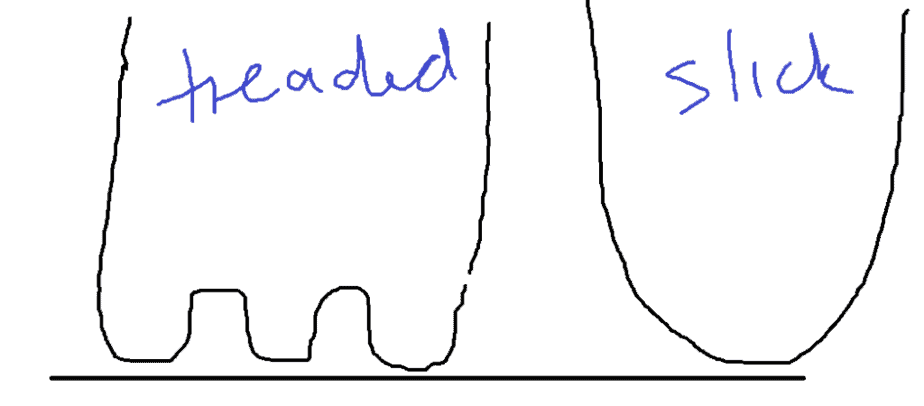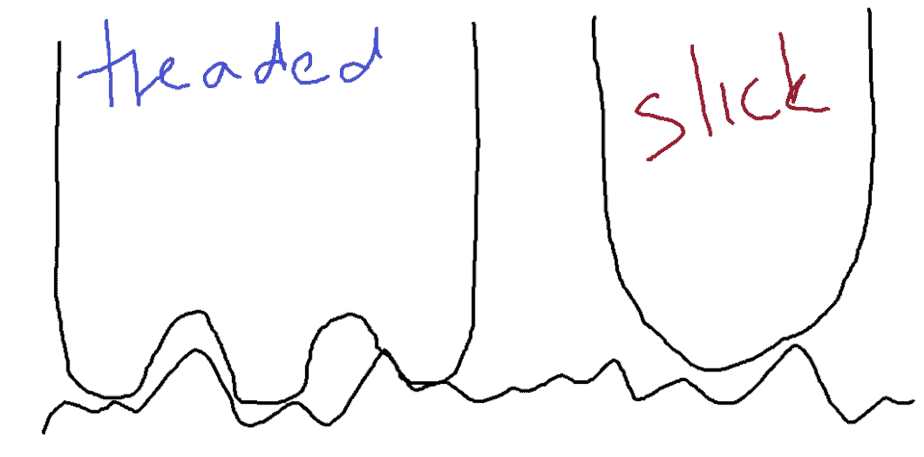If you are replacing your bike tires, you may be wondering if you should choose slick tires or tires with treads. Is there a big difference in performance and in speed between the two options? Which one may be better for you?
On paved roads, the difference between the grip of slicks and tires with treads is not noticeable for a commuter. When riding off-road or on snow, treads provide a superior grip and a safer ride. The best all-rounder tire for year-round bike commuters is a touring tire with treads.
Here’s what you need to know as a commuter in a nutshell:
- slick tires have an equally good grip on asphalt (even slightly superior)
- when commuting, slick tires are as fast as tires with treads on paved roads
- treads perform better on off-road segments
- treads are more practical for most commuters because of their versatility
How tires grip the asphalt
The grip is important, because you avoid slipping and sliding when you accelerate, brake or turn. Grip is between your wheels and the road surface. A tire’s grip depends on friction and interlocking. They sound difficult, but in reality, they are simple to understand.
Electric bikes built for everything and priced for everyone. Shop Rad Power Bikes, America's #1 electric bike brand. Get out. Go further. Ride Rad.
Friction is when two moving surfaces come in contact with each other, and they resist each other. It depends on the type of road, the compound of the tire, and the weight of the bike and rider combined.

The irregularities of the road are like tiny hooks; when they meet the tire, they push into it and hug it. It’s called interlocking. The wider the tire, the more hooks can hug. The softer the tire compound, the deeper the hooks can push in.

Grip on paved roads
All the forces of accelerating, braking, and turning are transferred to the tarmac through the tires. Do slicks or treads transfer those forces more effectively on asphalt? Which one has a better grip in those conditions?
On paved roads, the amount and size of irregularities are negligible. There are no tiny hooks on the road surface that could hug the tire surface, so interlocking doesn’t come into play.

What about friction? Friction is determined by the material of the tire and the road and the weight of the rider and the bike combined. Therefore if the same person uses slick or treads of the same rubber compound on the same road the friction is the same.

There is no noticeable difference to the bike commuter in the bike’s grip using slicks or treads on a paved road.
What about wet conditions? The grip changes on wet roads but changes the same for both treads and slicks. There’s no noticeable difference between them.
But what about hydroplaning (skidding on water)? Do treads make a difference? Cars have much wider tires and travel at considerably higher speeds than bikes do, which makes hydroplaning possible. Bikes can’t reach speeds high enough that this can happen.
Commuting speed: Which is faster?
Can you feel a real difference in speed between slick and treads? Not really.

Tires are flexible, and they deform under the pressure of the weight of the bike and the rider. The part of the tire in contact with the tarmac deforms and recovers its original shape as it rolls on. In this process, energy is lost (noise, heat, and vibrations are generated), and the regains its original shape with less energy. This is barely visible to the naked eye.
Tires with treads deform more due to the grooves and channels on them. Slick tires hold their shape much better. As a result, more energy is lost in the deformation of treads, which makes slick tires faster. The difference, however, is ever so small that it can be counted in fractions of a second, which matter in a race, but how does it affect a bike commuter?
When bike commuting, you need to slow down, stop at lights and take turns. The difference between slicks and treads is not noticeable for most riders in the city. If you want to be faster, there are a number of factors that play a more important role than the tire treads, such as your body position on the bike or finding the optimum cadence, to name two.
Off-road and single track
Off-road surfaces are uneven and irregular and can be covered in gravel, leaves, sticks and mud, making them slippery. Friction between the road and the tire plays a less important role, and you rely more heavily on interlocking for grip. The treads of the tire and road irregularities hug each other and keep your bike from sliding out from under you.
When riding off-road, slick tires have much less grip, because it lacks the treads that can interlock with road irregularities. It is not impossible to ride off-road with slick tires, but your braking distance is longer, you can only corner at a slower speed, and when riding uphill, your rear wheel can spin out for lack of grip. For long off-road segments, tires with treads are your best bet.

Treads vs. slicks: puncture resistance
Puncture resistance doesn’t depend on the tire being slick or having treads but on how easy it is for sharp objects, such as shreds of glass or thorns to penetrate it. Tires are made puncture resistant with a special thick layer within the tire, which makes them harder to poke a hole through.
Among slick tires, the Continental Gatorskin (available on Amazon) has very good puncture resistance, and among tires with a pattern, the Schwalbe Marathon Plus (also available on Amazon) is used by many commuters.
I have used my Continental Ride Tour (also available on Amazon) for years and put thousands of miles in it with no punctures at all. I have been very happy with it. I have found it a reliable option at a convenient price point. I also tested several other excellent commuter tires in different price categories and compared them in this article.

Can you use slick tires in the winter?
If you need to ride your bike on snowy roads, slick tires will not work, as smooth tires can’t have a grip on snowy and icy surfaces. If you live in a part of the world where the winters are long and rough, and you need to ride on long snowy segments, you’re better off with tires with treads.
Treads provide a grip on soft snowy road surfaces and they can handle icy-snowy road segments.
However, even treads lose grip on sheets of ice. If the weather where you live can be rainy one day and likely to go below freezing point the next, only studded tires will you sufficient grip. The little metal studs come in direct contact with the ice like tiny little nails and keep you from losing control. Here’s an article I wrote about studded tires.
What kind of commuting are slick tires suited for?
Slick tires are best suited for long-distance commuters with long, straight stretches of paved roads on their way to work without off-road segments, and speed matters to them. In reality, most commuters don’t benefit from slick tires. Slick tires are best used for races, where even seconds count.
Use slick tires if you:
- ride on long segments of paved roads
- don’t have off-road segments
- don’t ride on snowy or icy surfaces most of the year or don’t mind changing tires when the weather changes
- speed and even seconds really matter to you (some people are just too competitive)
What kind of commutes are tires with treads for?
Treaded tires are suited for multiple types of commutes because of their versatility. They can be used for long and short-distance commutes alike, for year-round commuters who ride on low-quality roads or off-road as they cycle to work. You can use them in winter on snow and some moderately icy bits.
Use them if you:
- want a do-it-all tire that can handle low-quality, gravel roads
- have snow in the winter, and you want to run the same tire all year round
- aren’t obsessed with breaking speed records on your way to work.
Conclusion
Slick tires for commuting purposes in very specific cases can work. However, it seems useless to sacrifice the advantages of riding off-road and snowy surfaces for the little speed you gain that comes with slick tires on paved roads.
Happy Riding!
Other related questions:
When should you replace your bike tire?
The average lifespan of a bike tire is between 3000 and 6000 miles, but it is more important to check the condition of the tire than just go by a set number of miles. Some tires wear out sooner than others. Here are some factors that determine your tire’s lifespan:
- Rubber compound (softer tires wear sooner)
- Weight (your bike’s and yours together)
- Tire pressure
- Road surface you ride on most of the time
- How careful you are when it comes to curbs, potholes etc.
In tires with treads, the tread patterns start to fade, which is a good indicator of how much mileage is left in the tire.
The following symptoms indicate that you should replace your tires:
- You can see a flat spot on the center of your tire.
- The sidewall of your tire starts to crack.
- You start getting flats more often, even without hitting potholes or curbs.
- You see cuts or holes on your tire.
